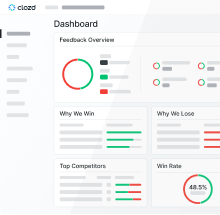In the realm of customer success, metrics like NPS (Net Promoter Score), CSAT (Customer Satisfaction Score), and Customer Health Scores are often heralded as the gold standard for gauging customer sentiment. However, while these metrics provide valuable insights, they don't always offer the full picture. For CX (Customer Experience) leaders, understanding the depth and nuances of customer feedback is crucial. This is where customer interviews come into play, offering a richer, more comprehensive view of customer experiences and expectations.
What Are NPS, CSAT, and Customer Health Scores?
Net Promoter Score (NPS)
NPS is a metric used to measure customer loyalty and satisfaction by asking customers how likely they are to recommend a company to others. The score is calculated based on responses to a single question, typically rated on a scale from 0 to 10. Customers are categorized as Promoters (9-10), Passives (7-8), or Detractors (0-6). The NPS is then derived by subtracting the percentage of Detractors from the percentage of Promoters.
Customer Satisfaction Score (CSAT)
CSAT measures customer satisfaction with a specific interaction or overall experience. Customers are asked to rate their satisfaction on a scale, often from 1 to 5. The CSAT score is the average of these responses, providing a snapshot of customer satisfaction at a given moment.
Customer Health Score
Customer Health Scores are composite metrics that assess the overall health of a customer relationship. These scores consider various factors such as product usage, customer engagement, and support interactions to predict the likelihood of retention or churn.
The Limitations of Traditional Metrics
While NPS, CSAT, and Customer Health Scores are valuable, they have limitations:
- Surface-Level Insights: These metrics provide quantitative data but often lack the qualitative insights needed to understand the "why" behind the scores.
- Snapshot in Time: They capture customer sentiment at a specific moment, which may not reflect long-term satisfaction or loyalty.
- Lack of Context: Without context, it's challenging to identify specific areas for improvement or understand the root causes of customer dissatisfaction.
The Depth of Customer Interviews
Customer interviews offer a solution to these limitations by providing in-depth, qualitative insights that traditional metrics cannot. Here's why they are essential:
Uncovering the "Why"
Customer interviews allow CX leaders to delve into the reasons behind customer feedback. By engaging directly with customers, companies can explore the motivations, emotions, and experiences that drive their satisfaction or dissatisfaction. This depth of understanding is crucial for developing effective strategies to enhance customer experience.
Contextual Insights
Interviews provide context that metrics alone cannot. They reveal the nuances of customer interactions, uncovering specific pain points and opportunities for improvement. This context is invaluable for tailoring solutions to meet customer needs and expectations.
Building Stronger Relationships
Engaging customers in interviews demonstrates a commitment to understanding their needs and valuing their input. This can strengthen customer relationships, increase loyalty, and reduce churn. Customers who feel heard and understood are more likely to remain loyal and advocate for the brand.
Comparing Metrics and Interviews
NPS vs. Customer Interviews
While NPS provides a quick measure of customer loyalty, it doesn't explain why customers feel the way they do. Customer interviews fill this gap by exploring the reasons behind the scores, offering actionable insights that can drive meaningful improvements.
CSAT vs. Customer Interviews
CSAT scores indicate satisfaction levels but lack the depth needed to understand customer experiences fully. Interviews provide the qualitative data needed to interpret CSAT scores, helping companies identify specific areas for enhancement.
Customer Health Scores vs. Customer Interviews
Customer Health Scores offer a predictive view of customer relationships but may miss the underlying factors influencing customer health. Interviews provide the detailed insights needed to understand these factors, enabling proactive management of customer relationships.
Implementing Customer Interviews
Best Practices for Conducting Interviews
- Define Clear Objectives: Determine what you want to learn from the interviews and tailor your questions accordingly.
- Select the Right Participants: Choose a diverse group of customers to gain a comprehensive view of customer experiences.
- Create a Comfortable Environment: Ensure that customers feel comfortable sharing their honest feedback.
- Ask Open-Ended Questions: Encourage detailed responses by asking questions that require more than a yes or no answer.
- Listen Actively: Pay attention to what customers are saying and probe deeper into their responses.
Leveraging Insights for Business Outcomes
The insights gained from customer interviews can drive significant business outcomes:
- Enhance Customer Experience: Use feedback to identify and address pain points, improving overall customer satisfaction.
- Reduce Churn: Understand the factors contributing to customer attrition and develop strategies to retain at-risk customers.
- Inform Product Development: Align product features and roadmaps with customer needs and expectations.
- Strengthen Competitive Advantage: Gain insights into customer preferences and market trends to stay ahead of competitors.
Conclusion
While NPS, CSAT, and Customer Health Scores are valuable tools for measuring customer sentiment, they don't provide the full picture. Customer interviews offer the depth and context needed to understand customer experiences truly. By integrating interviews into their feedback programs, CX leaders can gain the insights necessary to drive meaningful improvements, enhance customer satisfaction, and achieve long-term success. At Clozd, we believe that the source of truth isn't your CRM—it's your buyer. Embrace the power of customer interviews to uncover the real reasons behind customer feedback and make confident, data-driven decisions.











.svg)











.svg)

.svg)




